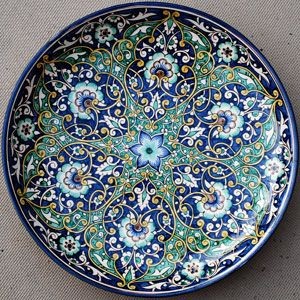- Home
- About US
- Art and Craft
- Artisans
- Master Crafts Persons
- Supporting Institutions
- News and Events
- Schemes
- Contact us
- Contact

Ceramic Art is art made from ceramic materials (including clay), which may take forms including art ware, tile, figurines, sculpture, andtableware. Ceramic art is one of the arts, particularly one of the visual arts, and of\ those, it is one of the plastic arts. While some ceramics are considered fine art, some are considered to be decorative, industrial or applied art objects. Ceramics may also be consideredartefacts in archaeology. Ceramic art can be made by one person or by a group of people. In a pottery or ceramic factory, a group of people design, manufacture and decorate the art ware.m Products from a pottery are sometimes referred to as "art pottery." In a one-person pottery studio, ceramists or potters produce studio pottery.
The word "ceramics" comes from the Greek keramikos (κεραμικος), meaning "pottery", which in turn comes from keramos (κεραμος) meaning "potter's clay." Most traditional ceramic products were made from clay (or clay mixed with other materials), shaped and subjected to heat, and tableware and decorative ceramics are generally still made this way. In modern ceramic engineering usage, ceramics is the art and science of making objects from inorganic, non-metallic materials by the action of heat. It excludes glass andmosaic made from glass tesserae.
There is a long history of ceramic art in almost all developed cultures, and often ceramic objects are all the artistic evidence left from vanished cultures
Elementsof ceramic art, upon which different degrees of emphasis have been placed atdifferent times, are the shape of the object, its decoration by painting, carvingand other methods, and the glazing found on most ceramics.
Materials-Different types of clay, when used with different minerals and firing conditions, are used to produce earthenware, stoneware, porcelain, and bone china (fine china).Earthenware is pottery that has not been fired to vitrification and is thus permeable to water. Many types of pottery have been made from it from the earliest times, and until the 18th century it was the most common type of pottery outside the far East. Earthenware is often made from clay, quartz and feldspar. Terracotta, a typem of earthenware, is a clay-based unglazed or glazed ceramic, where the fired body is porous. Its uses include vessels (notably flower pots), water and waste water pipes, bricks, and surface embellishment in building construction. Terracotta has been a common medium for ceramic art.
Stoneware is a vitreous or semi-vitreous ceramic made primarily from stoneware clay or non-refractory fire clay. Stoneware is fired at high temperatures. Vitrified or not, it is nonporous; it may or may not be glazed. One widely recognised definition is from the Combined Nomenclature of the European Communities, a European industry standard states "Stoneware, which, though dense, impermeable and hard enough to resist scratching by a steel point, differs from porcelain because it is more opaque, and normally only partially vitrified. It may be vitreous or semi-vitreous. It is usually coloured grey or brownish because of impurities in the clay used for its manufacture, and is normally glazed."
Tile-A tile is a manufactured piece of hard-wearing material such as ceramic, stone, metal, or even glass, generally used for covering roofs, floors, walls, showers, or other objects such as tabletops. Alternatively, tile can sometimes refer to similar units made from lightweight materials such as perlite, wood, and mineral wool, typically used for wall and ceiling applications. In another sense, a "tile" is a construction tile or similar object, such as rectangular counters used in playing games. The word is derived from theFrench word tuile, which is, in turn, from the Latin word tegula, meaning a roof tile composed of fired clay.
Tiles are often used to form wall murals and floor coverings, and can range from simple square tiles to complex mosaics. Tiles are most often made of ceramic, typically glazed for internal uses and unglazed for roofing, but other materials are also commonly used, such as glass, cork, concrete and other composite materials, and stone. Tiling stone is typically marble, onyx, granite or slate. Thinner tiles can be used on walls than on floors, which require more durable surfaces that will resist impacts.
Figurines-A figurine (a diminutive form of the word figure) is a statuette that represents a human, deity, mythical creature, or animal. Figurines may be realistic or iconic, depending on the skill and intention of the creator. The earliest were made of stone or clay. In ancient Greece, many figurines were made from terracotta. Modern versions are made of ceramic, metal, glass, wood and plastic. Figurines and miniatures are sometimes used in board games, such as chess, and tabletop role playing games. Old figurines have been used to discount some historical theories, such as the origins of chess.